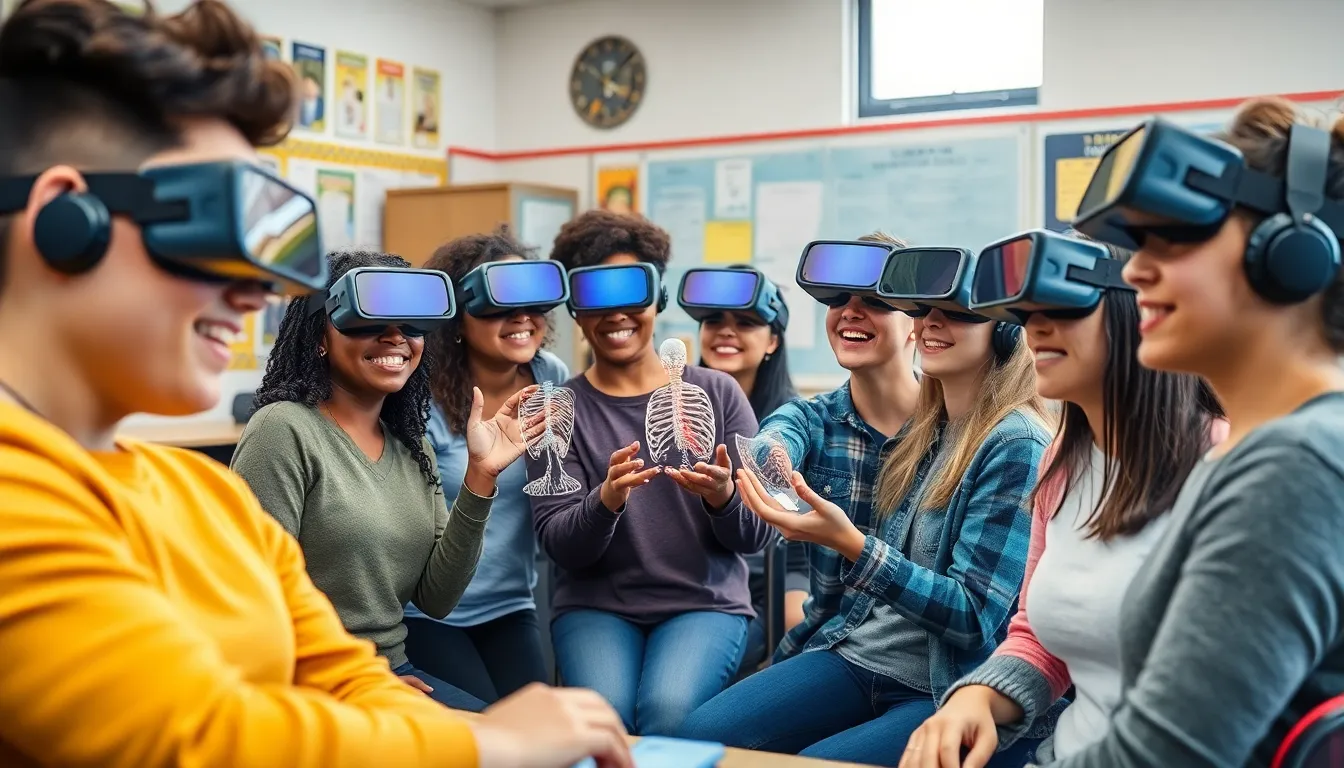Imagine a classroom where history comes alive and math problems leap off the page. With AR education tools, this isn’t just a dream—it’s the new reality. These innovative technologies are transforming the way students learn, making lessons more engaging and interactive than ever before.
Gone are the days of dull textbooks and endless lectures. AR tools invite students to explore, experiment, and experience concepts in a way that sticks. Whether it’s dissecting a virtual frog or walking through ancient ruins, the possibilities are endless.
As educators embrace this tech-savvy approach, they’re not just teaching—they’re captivating young minds and sparking curiosity. Dive into the world of AR education tools and discover how they’re reshaping the future of learning, one augmented lesson at a time.
Table of Contents
ToggleOverview of AR Education Tools
AR education tools transform traditional learning into interactive experiences. These technologies enhance student engagement through immersive visualizations. One example includes applications that allow students to explore human anatomy in 3D. This representation fosters better understanding of biological structures and functions.
In classrooms, AR tools provide hands-on learning opportunities. Students can manipulate virtual objects, enabling them to experiment with scientific principles. For instance, chemistry students might visualize molecular structures in a three-dimensional space. This approach makes complex concepts more accessible and relatable.
Several popular AR education platforms continuously evolve, adapting to various subjects. Google Expeditions offers virtual field trips, allowing learners to explore global landmarks. ClassVR, on the other hand, provides kits with AR headsets and software for schools. Interaction rates typically increase with such engaging platforms.
Teachers benefit from AR education tools, too. They can present materials in new, innovative ways, catering to diverse learning styles. Real-time feedback in AR applications allows instructors to gauge student understanding effectively. This capability enhances the teaching process, supporting individualized learning paths.
Various studies demonstrate the effectiveness of AR in enhancing retention rates. A report published by the University of Maryland found that students using AR tools scored 30% higher on tests. Another study published in the Journal of Educational Technology noted improved engagement levels. These statistics highlight the substantial potential of AR to reshape educational practices.
Benefits of AR Education Tools


Augmented reality education tools offer numerous advantages that enhance the overall learning process.
Enhanced Learning Experience
AR technologies immerse students in rich, interactive environments. Visualizations of complex subjects, such as human anatomy or historical events, make learning accessible. Students can interact with virtual objects, promoting hands-on activities. This method deepens comprehension and retention compared to traditional methods. Experiencing concepts directly fosters curiosity and pride in learning. Teachers observe that students grasp material more effectively through engaging AR experiences. Enhanced understanding becomes evident as students demonstrate improved performance in assessments.
Increased Engagement
AR tools significantly boost classroom engagement. Captivating experiences keep students motivated and attentive during lessons. By incorporating gamified elements, learners develop a sense of achievement when completing tasks. Attention spans increase as students explore content beyond the textbook. Collaboration among peers often occurs, fostering teamwork and social skills. AR applications also provide instant feedback, allowing students to recognize their progress. This real-time interaction cultivates a vibrant learning atmosphere where curiosity thrives. Research shows that students using AR scored 30% higher on tests, affirming the tools’ effectiveness in capturing interest.
Types of AR Education Tools
AR education tools come in various forms, including mobile applications and specialized hardware, enhancing immersive learning experiences.
Mobile Applications
Mobile applications epitomize convenience in AR education. They enable students to access interactive content on their smartphones and tablets. Applications like Google Expeditions allow learners to embark on virtual field trips, exploring historical landmarks and scientific phenomena. Interactive apps encourage students to engage with educational material through games and quizzes. Teachers utilize these applications to create dynamic lesson plans that cater to different learning styles. Regular updates on these platforms enhance their features, providing ongoing opportunities for enriched learning experiences.
AR Hardware
AR hardware adds another dimension to educational experiences. Devices like smart glasses and VR headsets enable users to visualize concepts beyond traditional screens. For instance, Microsoft HoloLens immerses students in detailed 3D environments, making complex subjects like mechanics and anatomy more comprehensible. These tools support hands-on learning by allowing users to manipulate virtual objects in real-time. Innovations in AR hardware continue to emerge, making it essential for educational institutions to integrate these technologies to stay current. By investing in AR hardware, schools foster collaborative learning and engagement among students.
Case Studies of AR in Education
AR education tools create immersive learning experiences. Numerous case studies illustrate their impactful applications.
Success Stories
In a middle school science class, students used Google Expeditions to explore the human circulatory system. Engaging with 3D models increased their understanding of complex biological concepts. In another instance, a high school history teacher employed AR to recreate ancient civilizations, which led to heightened student engagement and curiosity. Similarly, a university chemistry program integrated AR to visualize molecular structures, resulting in a significant improvement in retention rates. These success stories show AR’s ability to transform traditional learning methods into interactive, engaging experiences.
Lessons Learned
Educators discovered that integrating AR tools requires careful planning. Selecting appropriate applications that align with learning objectives proved essential. Training teachers to effectively use AR technologies maximized their benefit. Moreover, collaboration among students enhanced interaction and teamwork, reinforcing peer learning environments. Feedback highlighted that students thrived in hands-on learning scenarios that AR provided. While challenges exist, such as ensuring accessibility for all students, the benefits of AR in education far outweigh the drawbacks.
Challenges and Limitations
Challenges and limitations accompany the use of AR education tools. Accessibility remains a significant issue, as not all students have devices capable of supporting these technologies. Some schools lack the budget for specialized hardware or high-speed internet, hindering implementation.
User experience can vary considerably. Without proper training, educators may struggle to integrate AR tools effectively into their teaching methods. Technical difficulties, such as software glitches or hardware malfunctions, disrupt lessons and lead to frustration.
Adoption rates face obstacles, too. Limited familiarity with AR technology among teachers can inhibit enthusiasm for new methods. Schools often resist change due to traditional approaches dominating educational practices.
Moreover, content quality varies across platforms. Some AR applications may not align closely with curriculum standards. Low-quality content risks misinforming students or failing to engage them as intended.
Engagement does not guarantee comprehension. Students may interact with the AR material without fully grasping underlying concepts. This superficial understanding poses a risk in retaining new information over time.
Finally, overreliance on technology can diminish traditional learning skills. If students become accustomed to immersive experiences, they might struggle with conventional study methods. Maintaining a balanced approach is crucial for effective education.
Addressing these challenges requires concerted efforts from educators, administrators, and technology developers. Identifying solutions promotes more effective integration of AR tools, ensuring they enhance the learning experience rather than hinder it.
Future Trends in AR Education Tools
Emerging trends in AR education tools indicate a shift towards personalized learning experiences. Developers focus on adaptive content that adjusts to individual student needs, enhancing engagement and comprehension. Interactive platforms are increasingly integrating AI components, providing real-time feedback and assessments tailored to each learner’s progress.
The rise of cloud-based AR applications revolutionizes access to educational resources. With cloud technology, students can easily retrieve and share AR content from anywhere, fostering collaboration beyond the classroom. As internet connectivity improves, the potential for AR education expands, catering to remote learners and diversifying educational opportunities.
Growing interest in gamification leads to the incorporation of game elements within AR tools. By integrating achievements, leaderboards, and challenges, students become more motivated and invested in their learning. This playful approach creates a dynamic learning environment that captures students’ attention.
Increased collaboration with educational institutions shapes the design of AR tools. Developers actively seek feedback from educators to ensure alignment with curriculum standards and real-world relevance. As the AR market matures, partnerships between technology companies and schools will enhance tool effectiveness.
Fostering inclusivity becomes a priority, addressing the accessibility issues that have been noted. Innovations aimed at reducing barriers ensure all students can utilize AR tools, regardless of socioeconomic status or technological resources. By emphasizing user-friendly design, developers make these tools more approachable for diverse learning communities.
Finally, research continues to support the effectiveness of AR in education. Studies show that augmented reality tools significantly improve retention rates and engagement levels. The ongoing exploration of these trends positions AR education tools as vital components of future learning environments.
AR education tools are reshaping the landscape of learning by creating immersive experiences that engage students like never before. These innovative technologies not only enhance comprehension but also foster curiosity and collaboration among learners. As educators continue to integrate AR into their teaching practices, the potential for personalized and adaptive learning experiences grows.
Despite the challenges that remain, such as accessibility and the need for proper training, the benefits of AR tools are undeniable. By embracing these advancements, educational institutions can cultivate dynamic learning environments that cater to diverse needs. The future of education lies in the effective utilization of AR technology, promising a more engaging and interactive journey for students everywhere.





